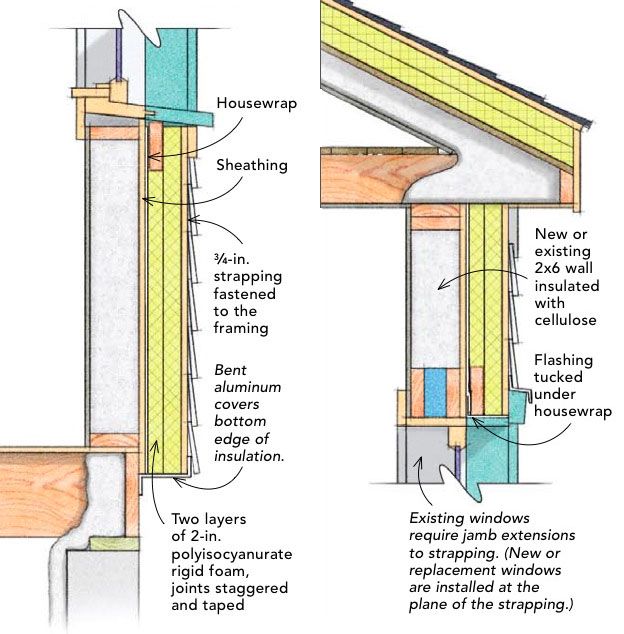
A popular way to retrofit insulation
Gregg Skoraczewski’s house in northern Wisconsin is framed with 2x4s and insulated with batt insulation–nothing unusual about that. What he’d like to do is strip the hardboard siding and fiberboard sheathing off the house, add new insulation from the outside and re-sheath and side the house, leaving interior walls intact.
Further Resources
Energy-Smart Details: Rigid foam on the roof and walls
Member video series: Flashing windows over rigid foam
Q&A: Foam sheathing, inside or out?
In his post at GreenBuildingAdvisor’s Q&A forum, Gregg adds that he’s been advised to add rigid foam insulation on the outside of the house to reduce thermal bridging through the framing. He wonders, however, whether this insulation strategy will leave an air space inside the wall that contributes to moisture accumulation.
In addition to reviewing his plans, this week’s Q&A Spotlight also touches on a perennial question: when adding rigid foam to a building’s exterior, how thick should be material be to prevent condensation inside the walls?
Read the whole article at Green Building Advisor.
Fine Homebuilding Recommended Products
Fine Homebuilding receives a commission for items purchased through links on this site, including Amazon Associates and other affiliate advertising programs.

Handy Heat Gun

Reliable Crimp Connectors

8067 All-Weather Flashing Tape

(click here to enlarge image) Foam sheathing has long been billed as an ideal way to upgrade poorly-insulated homes, but some builders and designers are still worried that it might trap moisture in the walls.



























View Comments
So Far So Good with 1" Polyiso.
Used 1" Foil Faced Polyiso Over 1/2" OSB all seems taped w/Foil Tape & Orange Nail Caps Foil Taped. Carefully nailed Hardie Plank siding with 3" Miaze nails into 16" OC 2x6 studs.
Siding rite over foam with no other "housewrap" or anything.
Used treated 1" deck at bottom & 1" untreated decking around all windows, corners Top. (Cheap & Avail. H Depot)
Inside is Reg. F Glass Batt insl. & 1/2" S Rock.
Also have older portion of house with 1" Polyiso on Interior walls and 1-1/2" Polyiso on Interior of Vaulted ceilings. Used 2" & 3" S Rock screws.
Worry constantly about condensation but seems to be OK. BUT - Much milder climate. 20' Cold Snap in winter maybe 2 weeks long at worst. Mostly 40 - 50' Drizzle 8 months/year.
Tore apart some to add porch "ledger" after 2 years & the OSB under seemed to be in fine shape (back side against F Glass could be rotten but I don't think so!)
No question that it insulates well. My 2 cents. Good Luck.
Would it be better for the bent aluminum flashing at the bottom to be behind the strapping and the seam taped to the polyiso to prevent it from holding water and causing it to run backwards to the house?
I agree that there is a serious problem with the bottom detail. Flashing should never retain water. The old time advice to follow the water is still good. So, the Aluminum Z should be turned over with the inside flange going behind the sheathing. This is going to leave a piece of metal protruding downward at the outside of the wall. This is how it should be -- a drip edge, but if the sharp edge is an issue, it should be folded over. If you want to close up the outside edge to prevent insects from getting into the space behind the siding, use a strip of insect screening (which will stop insects but not water). The bottom edge could go into the fold over on the Z flange if it is not completely closed and it could then be crimped to hold the screening in place.
This topic l as well need help with from a professional?,
I am renovating my father inlaws house built about 1955.
I have a musty smell been there about 15 years,but trying to explain to my inlaws never worked living there he never smelled it.
It has cathederal ceilings, when l gut it insulating walls l can do but how do l insulate a cathederal ceiling all rooms have beams showing not sure how to reinsulate ceilings?
crawling space a company who puts down 20 mil liner over dirt floor and up walls taping seems then spays stuff on block walls says will keep humidity below 60 a bit over 1,000 sq ft crawling space price for work $ 2,600.00 plus taxes, and l need to buy 16 bags of Roxul R22 24 inches wide strips this goes on wall.
If any pro's can advise me on this please email me at [email protected] soon as possible if you can.
Thanks
jim